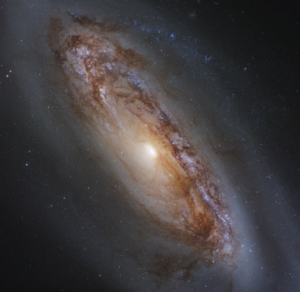Messier 90
| Galaxy Messier 90 |
|
|---|---|

|
|
| Image of the central area of Messier 90, created using the Hubble Space Telescope | |
| AladinLite | |
| Constellation | Virgin |
|
Position equinox : J2000.0 , epoch : J2000.0 |
|
| Right ascension | 12 h 36 m 49.8 s |
| declination | + 13 ° 09 ′ 47 ″ |
| Appearance | |
| Morphological type | SAB (rs) ab; LINER; Sy |
| Brightness (visual) | 9.4 mag |
| Brightness (B-band) | 10.2 mag |
| Angular expansion | 9.5 ′ × 4.4 ′ |
| Position angle | 23 ° |
| Surface brightness | 13.3 mag / arcmin² |
| Physical data | |
| Affiliation | Virgo Galaxy Clusters |
| Redshift | −0.000784 ± 0.000013 |
| Radial velocity | (−235 ± 4) km / s |
|
Stroke distance v rad / H 0 |
(44 ± 8) x 10 6 ly (13.5 ± 2.5) Mpc |
| Dimensions | approx. 5 × 1012 M☉ M ☉ |
| history | |
| discovery | Charles Messier |
| Discovery date | March 18, 1781 |
| Catalog names | |
| M 90 • NGC 4569 • UGC 7786 • PGC 42089 • CGCG 70-192 • MCG + 2-32-155 • IRAS 12343 + 1326 • VCC 1690 • Arp 76 • GC 3111 • | |
Messier 90 (also known as NGC 4569) is a 9.4 mag bright bar-spiral galaxy with an area of 9.5 '× 4.4' in the constellation Virgo . The galaxy is a member of the Virgo galaxy cluster and is believed to be gravitationally coupled to the galaxy IC 3583 ( Arp 76 ). Halton Arp organized his catalog of unusual galaxies into groups according to purely morphological criteria. This galaxy belongs to the class spiral galaxies with a small companion of high surface brightness on one arm (Arp catalog) .
Messier 90 is a Sab-type galaxy in the Hubble sequence , but appears to be quite old for a galaxy of this type. The galaxy has no star formation regions and it is therefore believed that the galaxy will evolve into a lenticular system with no S0-type spiral arms.
The distance has been determined variously, mainly with the help of the Tully-Fisher relationship , with values ranging from 9.3 to 16.8 Mpc .
In contrast to the similarly large galaxy Messier 89 , which is only 0.6 ° south, it is moving towards us at almost the same speed . This can be explained by the dynamics of the very massive Virgo Cluster.
The galaxy was discovered on March 18, 1781 by the French astronomer Charles Messier .
Web links
- M90 at SEDS
- Spektrum.de : Amateur recordings [1]
- Arp Atlas of Peculiar Galaxies
- Seligman Arp
literature
- Jeff Kanipe and Dennis Webb: The Arp Atlas of Peculiar Galaxies - A Chronicle and Observer's Guide , Richmond 2006, ISBN 978-0-943396-76-7




